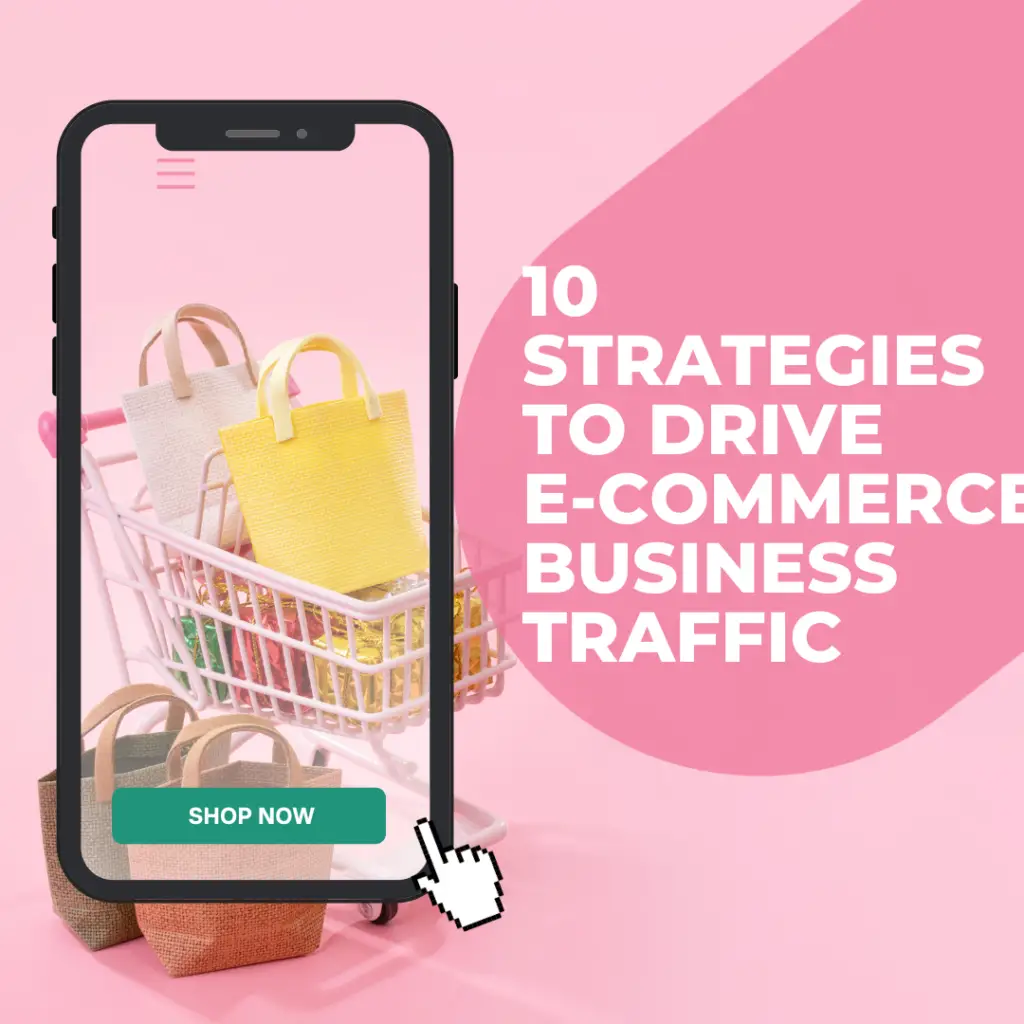Would you like 10,000 or 100,000 monthly visitors to your e-commerce business?
Driving traffic to an e-commerce website is becoming harder than ever. With more businesses transitioning online and investing more money into it, newer e-commerce businesses are now struggling to keep afloat. Will a large portion of the pie be eaten by larger brands? I think not.
Over 2.14 billion shoppers now buy items online, which is a significant increase from just a few years ago. With the current world population of 7.9 billion, it means that 27% of all people who are alive are digital buyers. Businesses such as our HustleVenture; which provides SEO writing services still do get online customers from time to time.
Several effective strategies can help boost website traffic and increase conversions. In this article, we will explore five key strategies that can significantly impact the success of an e-commerce business.
Key Takeaways
- Optimizing website performance is essential for improving user experience and increasing website traffic.
- Implementing effective SEO techniques such as keyword research, creating high-quality content, and building quality backlinks can greatly enhance website visibility and organic traffic.
- Social media marketing plays a vital role in driving traffic to an e-commerce website through engaging social media posts, influencer marketing, and social media ad campaigns.
- Email marketing is a powerful tool for building customer relationships and driving repeat traffic by building an email subscriber list, segmenting and personalizing email campaigns, and implementing automated email workflows.
- Paid advertising can be an effective strategy for driving targeted traffic to an e-commerce website by running Google Ads campaigns, utilizing Facebook Ads, and exploring native advertising platforms.
Optimizing Website Performance

User experience is everything when it comes to building your online traffic. According to a study by Google, users form an opinion about a website in just 0.05 seconds after the page loads. A delay of just one second in page load time can lead to a 7% reduction in conversions and 40% of visitors will abandon a website if it takes more than three seconds to load.
Improving Page Load Speed
Improving the page load speed of an e-commerce website is crucial for providing a seamless user experience and boosting conversion rates. Slow-loading pages can lead to high bounce rates and frustrated visitors who are more likely to abandon their shopping carts.
To optimize page load speed, several strategies can be implemented:
- Minimize HTTP requests: Reduce the number of requests made to the server by combining multiple files into one or using CSS sprites.
- Enable browser caching: Leverage browser caching to store static resources, such as images and scripts, locally on the user’s device.
- Compress and optimize images: Use image compression techniques to reduce file sizes without sacrificing quality.
Tip: Consider using a content delivery network (CDN) to distribute website content across multiple servers, improving load times for users in different geographical locations.
By implementing these strategies, e-commerce businesses can significantly improve their website’s page load speed and provide a better user experience.
Implementing Caching Mechanisms
Caching allows the website to store frequently accessed data, such as HTML pages, images, and scripts, in a temporary storage location. This reduces the load on the server and improves the page load speed for users.
One way to implement caching is by using browser caching. By setting appropriate cache headers, the browser can store static resources locally, allowing them to be retrieved quickly without requesting the server. This significantly improves the website’s performance.
Another caching mechanism is server-side caching. This involves storing dynamic content, such as database queries or API responses, in a cache. When the same content is requested again, it can be served from the cache instead of generating it from scratch, resulting in faster response times.
To summarize, implementing caching mechanisms is essential for optimizing website performance. It improves page load speed, reduces server load, and enhances the overall user experience.
Optimizing Images and Videos
When it comes to optimizing images and videos on your e-commerce website, there are several strategies you can implement to improve performance and enhance user experience:
- Compress your images and videos to reduce their file size without compromising quality. This can significantly improve page load speed and reduce bandwidth usage. Additionally, consider using lazy loading techniques, which delay the loading of images and videos until they are needed, further improving page load times.
- Optimize the file formats of your images and videos. For example, using modern image formats like WebP or AVIF can result in smaller file sizes compared to traditional formats like JPEG or PNG. Similarly, using video codecs like H.264 or VP9 can help reduce the file size of videos.
- To help you track the performance of your images and videos, you can utilize tools like Google PageSpeed Insights or GTmetrix. These tools provide insights and recommendations for optimizing your media files.
Focus on optimizing images and videos is crucial for improving website performance. By compressing, optimizing file formats, and tracking performance, you can ensure that your e-commerce website loads quickly and provides a seamless user experience.
Search Engine Optimization (SEO)

No point writing content if Google isn’t able to share it.
If you want your brand to stick out, you need SEO (search engine optimization). SEO allows you to lead the customer through your buying process. In addition to visibility and increased website traffic, SEO contributes to your company’s authoritative voice in your industry. And that authority builds brand trust, which ultimately becomes brand loyalty.
Keyword Research and Optimization

To get online traffic and outreach, keyword research is 90% of the content writing work. If you don’t find the good ones, you will spend more time and effort on little growth. And that’s something you wouldn’t want. It took HustleVenture 1 year to get over 1 million impressions and we are still actively writing SEO content.
It’s not an easy work.
By identifying the right keywords that align with the target audience’s search intent, businesses can improve their website’s visibility in search engine results pages (SERPs). To conduct effective keyword research, e-commerce businesses can follow these steps:
- Identify relevant topics: Start by brainstorming and researching topics that are relevant to the products or services offered. This will help in generating a list of potential keywords.
- Use keyword research tools: Utilize keyword research tools like Google Keyword Planner, SEMrush, or Moz Keyword Explorer to identify popular and relevant keywords related to the chosen topics.
- Analyze keyword competition: Evaluate the competition level for each keyword to determine the difficulty of ranking for them. Focus on targeting keywords with a good balance of search volume and competition.
Pro Tip: Regularly monitor keyword performance and make adjustments to the optimization strategy based on the insights gained.
By optimizing website content with the identified keywords, e-commerce businesses can improve their chances of ranking higher in search results and attracting targeted organic traffic.
Creating High-Quality Content
Quality content not only helps in building trust with the audience but also improves search engine rankings.
When creating content, it is important to focus on relevant keywords that are commonly used by the target audience. By conducting thorough keyword research, businesses can optimize their content to rank higher in search engine results. This can be achieved by providing in-depth insights, solving common problems, or sharing expert advice. By offering unique and valuable content, businesses can establish themselves as thought leaders in their industry.
To ensure the content is engaging and easy to read, it is important to format it properly. This includes using subheadings, bullet points, and short paragraphs. By breaking down the content into smaller sections, it becomes more scannable and digestible for the readers.
To summarize, creating high-quality content involves keyword optimization, providing valuable information, and formatting the content in an engaging and readable manner.
Building Quality Backlinks
Building quality backlinks is crucial for improving a website’s search engine rankings and driving organic traffic. Backlinks are links from other websites that point to your site, and they serve as a vote of confidence in your content. Here are some strategies to help you build high-quality backlinks:
- Guest blogging: Writing guest posts for reputable websites in your industry can help you establish your expertise and earn valuable backlinks.
- Content promotion: Creating valuable and shareable content can attract natural backlinks from other websites and social media platforms.
- Outreach: Reaching out to influencers, bloggers, and website owners in your niche can lead to collaborations and opportunities for backlinking.
Tip: When building backlinks, focus on quality over quantity. Aim for links from authoritative websites that are relevant to your industry.
By implementing these strategies, you can strengthen your website’s authority, improve its visibility in search engine results, and ultimately drive more traffic to your e-commerce business.

Looking for marketing services to help you boost awareness?
Here at HustleVenture, we are a finance and side hustle newsletter business. So if you are reading this, chances are, we can help you grow your side hustle/business through some of our online services such as:
- SEO writing [Popular⭐]
- Web design
- Videography [Singapore Only]
- Advertising [Popular⭐]
- Copywriting
- Guest post promotion
These are just some ways we can do to promote your business/side hustle. Interested to know more, be sure to schedule a Zoom call with us down below!

Social Media Marketing

While searchers are considered high-quality reach, the best way for your business to get visibility fast is through social media. It’s not easy though as viewers are constantly chasing after the next trend and it’s hard for businesses to keep up. If you are someone who loves to use social media and is good at creating engaging content, this is what you should focus on.
With that being said, if your e-commerce business doesn’t target the mass audience, pumping your effort into it might be a waste of time. It would be better of though ads where you can select the target audience you are looking for.
Creating Engaging Social Media Posts
Bold and italics can be used strategically to highlight important keywords and add subtle emphasis.
One effective way to create engaging social media posts is by using eye-catching visuals. Incorporate high-quality images and videos that are relevant to your brand and message. Visual content is more likely to grab the attention of users as they scroll through their social media feeds.
Another strategy is to write compelling captions that accompany your posts. Use italics to emphasize key points or to create a sense of urgency. Captions should be concise, yet informative, providing enough context to entice users to click through to your website.
Additionally, consider using hashtags strategically. Research popular hashtags that are relevant to your industry or niche and incorporate them into your posts. This can help increase the visibility of your content and attract users who are interested in the topics you are discussing.
Finally, engage with your audience by responding to comments and messages. Encourage discussions and ask questions to foster interaction. This not only helps build a sense of community but also increases the likelihood of users sharing your posts, thereby driving more traffic to your website.
Remember, creating engaging social media posts is an ongoing process. Continuously monitor the performance of your posts and adjust your strategies as needed to optimize engagement and drive traffic to your website.
Utilizing Influencer Marketing
By partnering with influencers in your industry, you can tap into their large and engaged audience to promote your products or services. Collaborating with influencers who align with your brand values and target audience can significantly increase your website traffic.
To make the most out of influencer marketing, consider the following strategies:
- Identify relevant influencers: Research and identify influencers who have a strong following in your niche. Look for influencers who have a genuine connection with their audience and regularly engage with them.
- Build authentic relationships: Instead of approaching influencers with a one-time collaboration, focus on building long-term relationships. This can help you establish trust and credibility with the influencer’s audience, leading to higher click-through rates and conversions.
- Create compelling content: Work closely with influencers to create engaging and authentic content that resonates with their audience. This can include product reviews, tutorials, or sponsored posts that highlight the benefits of your products or services.
- Track and measure results: Use tracking tools and analytics to monitor the performance of your influencer marketing campaigns. This will help you identify which influencers are driving the most traffic to your website and optimize your future collaborations.
Remember, influencer marketing is not just about reaching a large audience. It’s about connecting with the right audience and building trust. By leveraging the influence of trusted individuals in your industry, you can drive targeted traffic to your ecommerce website and increase your chances of converting visitors into customers.
Running Social Media Ad Campaigns
Leveraging the power of social media platforms like Facebook, Instagram, and Twitter, businesses can reach a wide audience and promote their products or services. Targeting is a key aspect of running successful ad campaigns. It allows businesses to focus their efforts on specific demographics, interests, and behaviors, ensuring that their ads are seen by the right people.
To make the most of social media ad campaigns, businesses should consider the following strategies:
- A/B testing: Testing different ad variations can help identify the most effective messaging, visuals, and calls-to-action. By experimenting with different elements, businesses can optimize their ads for better performance.
- Remarketing: Targeting users who have previously interacted with the website or shown interest in the products can be highly effective. Remarketing ads can help remind potential customers and encourage them to revisit the website.
- Monitoring and optimization: Regularly monitoring the performance of ad campaigns and making necessary adjustments is crucial. Analyzing metrics like click-through rates, conversion rates, and cost per click can provide insights for improving campaign effectiveness.
In addition to these strategies, businesses should also keep in mind some important tips:
Consistency: Maintaining a consistent brand voice and visual identity across all ad campaigns helps build brand recognition and trust.
Call-to-action: Including a clear and compelling call-to-action in the ad can encourage users to take the desired action, such as visiting the website or making a purchase.
Ad placement: Choosing the right ad placement on social media platforms can significantly impact the visibility and success of the campaign.
By implementing these strategies and following best practices, businesses can drive more traffic to their e-commerce website through social media ad campaigns.
Email Marketing

If your website is getting a huge amount of traffic and you are looking to get hold of your loyal fans, you need an email subscription to your website.
Building an Email Subscriber List
Building an email subscriber list is a crucial step in growing your e-commerce business. By capturing the email addresses of your website visitors, you can establish a direct line of communication with your target audience. Here are some effective strategies to build your email subscriber list:
- Offer valuable incentives: Provide your website visitors with a compelling reason to subscribe to your email list. This could be in the form of a discount, exclusive content, or access to special promotions.
- Optimize your opt-in forms: Make sure your opt-in forms are prominently displayed on your website and are easy to fill out. Keep the form fields to a minimum to reduce friction and increase conversions.
- Segment your audience: Divide your email subscribers into different segments based on their interests, demographics, or purchase history. This allows you to send targeted and personalized emails that resonate with each segment.
Pro tip: Regularly clean your email list by removing inactive subscribers to maintain a high deliverability rate.
By implementing these strategies, you can build a strong and engaged email subscriber list that will help drive traffic to your ecommerce website.
Segmenting and Personalizing Email Campaigns
Segmenting and personalizing email campaigns is a crucial strategy for maximizing the effectiveness of your email marketing efforts. By dividing your email subscribers into specific segments based on their demographics, preferences, or behaviors, you can tailor your messages to resonate with each group.
Segmentation allows you to send targeted content that is relevant to the recipient, increasing the chances of engagement and conversion. For example, you can segment your subscribers based on their purchase history and send personalized product recommendations or exclusive offers.
Personalization goes beyond just addressing the recipient by their name. It involves customizing the content of your emails based on the recipient’s interests, preferences, or previous interactions with your brand. This can include recommending relevant blog posts, suggesting products related to their previous purchases, or sending birthday discounts.
To effectively segment and personalize your email campaigns, consider the following strategies:
- Collect relevant data: Gather information about your subscribers that will help you create meaningful segments. This can include data such as age, location, purchase history, browsing behavior, or email engagement.
- Define your segments: Analyze the collected data to identify common characteristics or behaviors among your subscribers. Create segments based on these insights, such as segmenting by age group, geographic location, or product preferences.
- Craft tailored messages: Once you have defined your segments, create email content that speaks directly to each group. Use language, offers, and visuals that resonate with their specific interests or needs.
- Automate your campaigns: Implement automated email workflows that trigger specific emails based on predefined conditions or actions. For example, you can set up a welcome email series for new subscribers or send a follow-up email to customers who abandoned their shopping carts.
By segmenting and personalizing your email campaigns, you can deliver targeted and relevant content to your subscribers, increasing engagement, and driving conversions.
Implementing Automated Email Workflows
Implementing automated email workflows can greatly enhance an ecommerce business’s marketing efforts. By setting up a series of automated emails triggered by specific actions or events, businesses can deliver personalized and timely messages to their subscribers. This not only helps in building stronger relationships with customers but also increases the chances of driving repeat purchases.
One effective way to implement automated email workflows is by segmenting the subscriber list based on various criteria such as purchase history, browsing behavior, or demographic information. This allows businesses to send targeted emails that are relevant to each segment, increasing the likelihood of engagement and conversion.
Benefits of implementing automated email workflows:
- Improved customer engagement: Automated emails can be tailored to the specific needs and interests of subscribers, resulting in higher open rates and click-through rates.
- Increased customer retention: By nurturing relationships through automated emails, businesses can encourage repeat purchases and foster long-term loyalty.
- Time and resource efficiency: Once set up, automated email workflows can run on autopilot, saving time and effort for the business.
In conclusion, implementing automated email workflows is a valuable strategy for ecommerce businesses looking to drive traffic to their website. By delivering personalized and timely messages to subscribers, businesses can enhance customer engagement, increase retention, and ultimately boost conversions.
Paid Advertising
Running Google Ads Campaigns
Running Google Ads campaigns is a crucial strategy for driving traffic to an ecommerce website. With Google Ads, businesses can target specific keywords and display their ads to potential customers who are actively searching for products or services. Keyword research is essential for identifying the most relevant and high-performing keywords to include in the ad campaigns.
Once the keywords are determined, businesses can create compelling ad copy that highlights their unique selling points and encourages users to click on the ads. It’s important to continuously monitor and optimize the ads to improve their performance and maximize the return on investment.
To track the effectiveness of Google Ads campaigns, businesses can utilize conversion tracking. This allows them to measure the number of conversions generated from the ads, such as purchases or sign-ups. By analyzing the conversion data, businesses can make data-driven decisions to optimize their campaigns and allocate their budget effectively.
In addition to conversion tracking, businesses can also benefit from remarketing. This strategy involves targeting users who have previously visited the website but did not make a purchase. By showing them relevant ads across the Google Display Network, businesses can increase brand awareness and encourage them to return and complete a purchase.
Overall, running Google Ads campaigns requires careful planning, keyword research, and continuous optimization. By leveraging the power of Google’s advertising platform, ecommerce businesses can drive targeted traffic to their website and increase their chances of converting visitors into customers.
Utilizing Facebook Ads
Facebook Ads is a powerful tool for driving traffic to your ecommerce website. With its extensive targeting options and large user base, you can reach a highly specific audience and increase your chances of converting them into customers.
One effective strategy is to create compelling ad copy that grabs the attention of your target audience. Use emotional language and highlight the unique selling points of your products or services. This will help you stand out from the competition and entice users to click on your ads.
To maximize the effectiveness of your Facebook Ads, consider the following tips:
- Set clear campaign objectives: Define what you want to achieve with your ads, whether it’s driving traffic, increasing sales, or building brand awareness.
- Test different ad formats: Experiment with different ad formats, such as carousel ads, video ads, or collection ads, to see which ones resonate best with your audience.
- Monitor and optimize: Regularly monitor the performance of your ads and make adjustments based on the data. Test different targeting options, ad placements, and ad creatives to find the winning combination.
Remember, Facebook Ads can be a valuable tool in your ecommerce marketing strategy, but it’s important to continuously analyze and optimize your campaigns to get the best results.
Exploring Native Advertising Platforms
Native advertising platforms provide a unique opportunity for ecommerce businesses to reach their target audience in a non-disruptive way. By seamlessly integrating promotional content into the user’s browsing experience, native ads can effectively capture attention and drive traffic to the website.
One advantage of native advertising platforms is the ability to target specific demographics and interests. This allows businesses to tailor their ads to the right audience, increasing the chances of engagement and conversion. Additionally, native ads often blend in with the surrounding content, making them less intrusive and more likely to be viewed and clicked on.
To make the most out of native advertising platforms, businesses should consider the following strategies:
- Research and select the right platforms: Not all native advertising platforms are created equal. It’s important to research and choose platforms that align with the target audience and business goals.
- Craft compelling ad copy: Native ads should be engaging, informative, and relevant to the target audience. Businesses should invest time in creating compelling ad copy that grabs attention and entices users to click through.
- Monitor and optimize performance: Regularly monitoring the performance of native ads is crucial. Businesses should analyze metrics such as click-through rates, conversions, and engagement to identify areas for improvement and optimize their campaigns.
In conclusion, exploring native advertising platforms can be a valuable strategy for e-commerce businesses looking to drive traffic to their website. By leveraging the unique advantages of native ads and implementing effective strategies, businesses can increase their visibility, attract the right audience, and ultimately boost website traffic and conversions.
what strategy would most help an e-commerce business drive traffic to its website?
Implementing a comprehensive digital marketing strategy is crucial for driving traffic to an e-commerce website.
By utilizing a combination of search engine optimization (SEO), social media marketing, content marketing, and paid advertising, businesses can increase their online visibility, attract more visitors, and ultimately boost sales. With the right approach, an e-commerce business can successfully drive traffic to its website and achieve long-term success.
Frequently Asked Questions
How can I improve the page load speed of my website?
To improve the page load speed of your website, you can optimize the code, compress images and files, minimize HTTP requests, and utilize caching mechanisms.
What is keyword research and how can it help with SEO?
Keyword research is the process of finding and analyzing the keywords that people use to search for information online. By incorporating these keywords into your website content, you can improve your search engine rankings and drive organic traffic to your website.
What are backlinks and why are they important for SEO?
Backlinks are links from other websites that point to your website. They are important for SEO because search engines consider backlinks as a vote of confidence in your website’s credibility and authority. Having high-quality backlinks can improve your search engine rankings and drive more traffic to your website.
How can I create engaging social media posts?
To create engaging social media posts, you can use compelling visuals, ask questions, run contests or giveaways, share valuable content, and interact with your audience through comments and messages.
What is influencer marketing and how can it help with social media marketing?
Influencer marketing is a strategy where businesses collaborate with influential individuals on social media to promote their products or services. By partnering with influencers who have a large and engaged following, you can reach a wider audience and increase brand awareness.
How can I build an email subscriber list?
To build an email subscriber list, you can offer incentives such as exclusive content or discounts in exchange for email sign-ups, create engaging opt-in forms on your website, promote your newsletter or mailing list on social media, and run targeted email sign-up campaigns.





